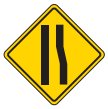2025 Tennessee Motorcycle Permit Test 8
The following questions are from real DMV written motorcycle permit tests. These are some of the actual permit questions you will face in Tennessee when getting your motorcycle learners permit. Each motorcycle theory practice test question has three answer choices. Select one answer for each question and select "grade this section." You can find this button at the bottom of the drivers license quiz. For a complete list of questions and answers for Tennessee please visit https://cheat-sheets.dmv-written-test.com/en/tennessee/motorcycle.
Number of Tests
Number of Question
Passing Score
1. Footrests:
Explanation
Keep your feet firmly on the footrests for balance. The motorcycle should be equipped with passenger footrests. Firm footing prevents your passenger from falling off and pulling you off, too.
2. What does this sign mean?

Explanation
Warning signs are yellow with black lettering or symbols and provide important information to motorists about upcoming road conditions. This sign warns that the right lane ends ahead.
3. When riding on a slippery surface, you should:
Explanation
On a slippery surface, any sudden change in speed or direction could result in a skid. Be as smooth as possible when you speed up, shift gears, turn, or brake on such a surface.
4. When riding on a slippery surface, you should:
Explanation
On a slippery surface, any sudden change in speed or direction could cause a skid. Accelerate, shift gears, turn, and brake as smoothly as you can when riding on a slippery surface.
5. If you are riding behind another vehicle at night, you can determine if there are bumps on the road ahead by:
Explanation
To determine upcoming road conditions when riding at night, use the vehicle ahead of you. For example, the headlights of the vehicle may provide a better view of the road than your own high beam. If the vehicle's taillights bounce up and down, this indicates the presence of bumps on the road.
6. Mirrors on motorcycles:
Explanation
The mirrors of motorcycles have blind spots, just like those of cars. Always turn your head to check your blind spot before changing lanes.
7. When braking on a motorcycle:
Explanation
